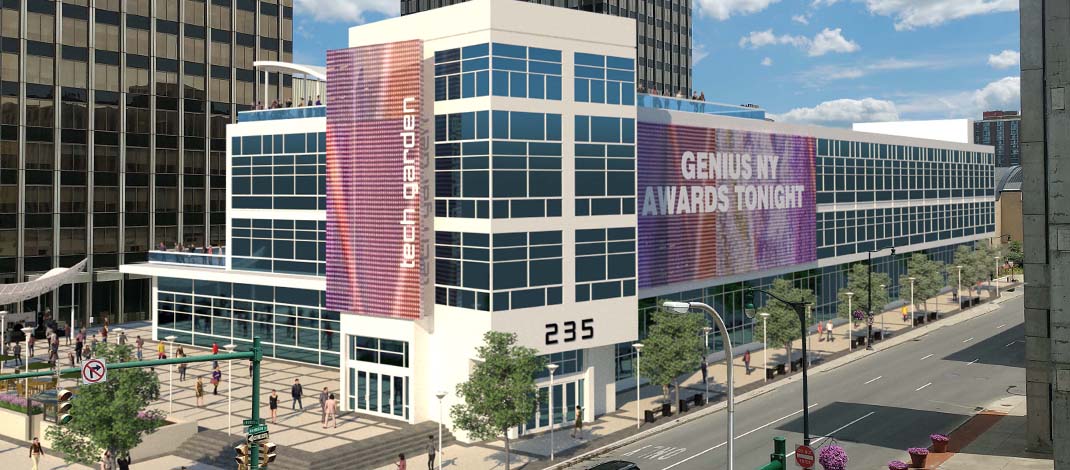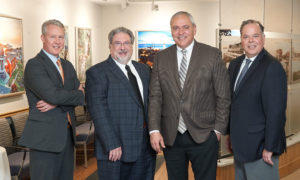Region is one of 60 finalists for the U.S. Economic Development Administration’s $1 billion Build Back Better Regional Challenge
By Ken Sturtz
Central New York and the Mohawk Valley are in the running to receive upwards of $100 million for multiple economic development projects as part of a pandemic recovery program.
The economic development organization CenterState CEO worked with more than a dozen municipalities and agencies to submit a joint application for the Central New York and Mohawk Valley regions. The proposal focuses on training workers to enter in-demand fields and on expanding the area’s semiconductor, drone and quantum computing industries.
CenterState was one of 60 finalists announced in December by the Commerce Department for the U.S. Economic Development Administration’s $1 billion Build Back Better Regional Challenge.
The competition is one of the American Rescue Plan programs aimed at boosting economic pandemic recovery.
The 60 finalists were chosen from more than 500 applicants across 45 states. Each will receive a $500,000 grant to further develop their proposals. The finalists proposed projects that represent industries unique to each region, including advanced manufacturing; aerospace and defense; agriculture and natural resources; biotechnology and biomanufacturing; energy and resilience; health care and digital health; information technology; transportation; construction and logistics; and water and blue economy.
Benjamin Sio, chief of staff for CenterState, says that while there was no requirement for the proposed projects to support established industries in the region, they made the decision to focus on investing in existing industries.
“We were very intentional in saying we believe that EDS [Economic Development Administration] wants to invest in things that are not just flashes in the pan,” Sio says. “It’s stuff that we’ve been working to make a reality for a fair amount of time.”
Seven of the eight economic development projects proposed by CenterState — including one in Oswego County and three in Onondaga County — aim to build on existing projects and industries, some of which have been in the works for much of the last decade.
![Ben Sio, CenterState CEO chief of staff: “We were very intentional in saying we believe that EDS [Economic Development Administration] wants to invest in things that are not just flashes in the pan,” Sio says. “It’s stuff that we’ve been working to make a reality for a fair amount of time.”](https://www.oswegocountybusiness.com/wp-content/uploads/2022/02/Ben-Sio-206x300.jpg)
Although most of the proposed projects would support existing industries and have been on the drawing board for a while, the economic development competition offers an opportunity to make them a reality much sooner than would otherwise be possible, Sio says.
“These projects are very much in the public mind,” he says. “They’ve been announced, but we’re closing funding gaps they may have and bringing them to fruition.”
The eight projects proposed in CenterState’s application include:
• White Pine Commerce Park: Economic development officials have been trying to attract a semiconductor chip manufacturer to the 1,200-acre site in Clay. The application says two semiconductor manufacturers are considering building a plant there. $25 million in federal grant money would support $45 million worth of infrastructure improvements at the site. The project would potentially become the region’s largest manufacturer.
• Marcy Nanocenter: Located at SUNY Polytechnic Institute in Oneida County, $7.75 million in grant funding would support $14.25 million to build a 75,000-square-foot flex space for companies supplying semiconductor and advanced manufacturing industries.
• Oswego County Industrial Park: $7.5 million would support a $10 million, 200-acre expansion at the site to attract supply chain companies for the semiconductor industry. The goal would be to create 500,000 square feet of manufacturing space in the first 10 years. As many as 500 jobs would be created at the industrial park, which is located in the town of Schroeppel in southern Oswego County.
• Center City Innovation Hub: $7 million would help a $46.5 million expansion of CenterState’s Syracuse Tech Garden high-tech business incubator. The new Center City Innovation Hub will be designed to attract startups that can benefit from its specialized slate of services and resources. It will also host the New York State Center for Smart Cities, serving as the test site for smart cities technology and data hub for Syracuse.
• New York UAS Test Site: Federal funding would contribute $12 million to a $20 million project to expand and make critical enhancements to the Rome drone testing site operated by NUAIR Alliance. SUNY Upstate Medical University would also partner with NUAIR to launch a program running on-demand drone flights from the Regional Blood Bank in Rochester to Upstate’s cancer center in Syracuse.
• Smart Systems Cluster Advanced Manufacturing Training Consortium: $8 million in federal dollars will support the $9.6 million consortium project, which will bring together educational institutions, industry groups and community organizations across multiple counties to build a workforce pipeline for smart systems demand occupations.
• STEAM School at Central Tech: The long vacant Central Technical High School in downtown Syracuse would be renovated and house the first regional high school in the state focusing on science, technology, engineering, arts and math. The school would be accessible to all 25 school districts in the OCM BOCES district. $10 million in federal funding would go toward the $85 million project.
• Quantum Computing Research and Infrastructure: $10 million would support a $12 million investment in quantum computing research. The Griffiss Institute, along with Syracuse University, would accelerate research of quantum technologies, entrepreneurship and commercialization. Other partners would scale up and integrate quantum tracks into community STEM programs to build a more diverse workforce.
Finalists will compete in the second phase of the challenge. Ultimately 20 to 30 regional coalitions will be awarded up to $100 million to implement three to eight projects that support an industry sector. The deadline for the second phase is in March and the award announcement is expected in the fall.
Featured image: An artist’s rendering of the The Center City Innovation Hub in Syracuse, one of the proposed projects that can become a reality.



